LANDSCAPES BY MUNNINGS EXHIBITION AT GAINSBOROUGH’S HOUSE

One of Sir Alfred Munnings paintings.
An exhibition bringing together over thirty magnificent paintings by Sir Alfred Munnings (1878-1959) will be shown at Gainsborough’s House this Spring. Landscape Paintings by Sir Alfred Munnings is the first exhibition to be devoted solely to landscapes by Munnings. It has been selected from the collection of the Sir Alfred Munnings Art Museum at Castle House, Dedham, where Munnings lived from 1919 until his death. It opened as a museum in 1961, the same year that Gainsborough’s House opened to the public. It was Munnings, in fact, who had generously given one of his paintings for sale, who helped to make the purchase of Gainsborough’s House possible.
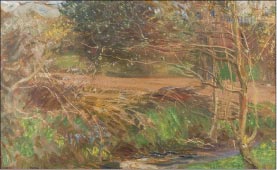
A pastoral scene with trees and a stream in the foreground.
Sir Alfred Munnings was a leading figure in the British art establishment in the first half of the 20th century and is one of the greatest equestrian painters in the history of British art. Although it was his horse portraits that brought him widespread acclaim, he was also a highly accomplished painter of pure landscapes, as the exhibition will hope to demonstrate.
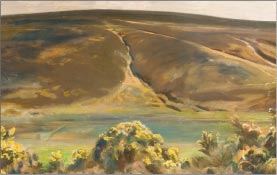
Mill Hill, Oar, Exmoor.
Munnings rose from rather lowly beginnings as the son of a mill owner, to become President of the Royal Academy, one of the very few ‘sporting’ artists to achieve such an accolade. He received his knighthood in 1944. His early years were spent in Mendham on the Norfolk/Suffolk border, followed by an apprenticeship as a lithographer and artistic training in Norwich.
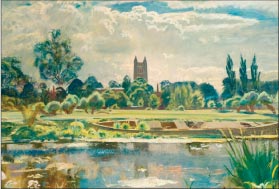
A barge on the Stour at Dedham.
As a native of East Anglia, Munnings followed in the footsteps of Thomas Gainsborough and John Constable. Like them, he drew his inspiration from the surrounding countryside, with its flat terrain, river banks and open skies. During World War II, he lived on Exmoor, where he painted a bleaker and more dramatic landscape but with an equal devotion to direct observation and a passion for colour, light and form. The landscapes of Munnings are very different, of course, from those of Gainsborough. He was less interested in the activities of country people or animals and concentrated on the simple landscape elements of hills, foliage and skies. They were evocative of particular times, places and seasons and he was particularly interested in the ever changing effects of light and shade and of the weather. Munnings painted some extraordinary observations of the shadows cast by clouds on a hillside or landscapes in the snow – a difficult subject for an artist that neither Gainsborough nor Constable dared to tackle.
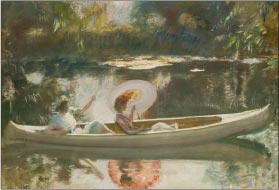
Study for The White Canoe.
Many of the paintings on display at Gainsborough’s House, such as A Barge on the Stour at Dedham and Langham Mill Pool on the Stour are of places renowned for their picturesque beauty and remain largely unchanged to this day. The stretch of the Stour between Dedham and Flatford, now so popular with tourists and Constable enthusiasts, is the easily identifiable backdrop
to a series of subjects that Munnings made of a white canoe, represented in the exhibition by The White Canoe on the Stour at Flatford. Other landscapes by Munnings are more personal to the artist, including scenes of his gardens at Dedham and at Withypool, Exmoor.
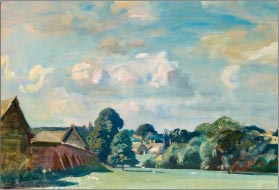
Suffolk landscape with farm buildings.
What sets Munnings apart from so many other artists of his era is his sheer ability as a painter, which is perhaps even more apparent in his landscapes than in some of his more laboured equestrian commissions. The freedom and spontaneity of his brushstrokes and his obvious enjoyment in the lusciousness of the paint itself combined brilliantly with his subtle and highly individual colouring.
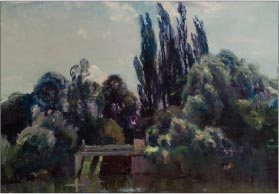
Langham Mill Pool on the Stour.
By focusing on his pure landscapes alone, the exhibition aims to highlight a lesser-known, yet equally fascinating, aspect of Munnings’s work. The artist has something of a mixed reputation today. While he is widely regarded as one of Britain’s greatest painters and his work fetches large sums at auctions and other sales, his life and works have, surprisingly, not been widely researched and he is rarely the focus of books or exhibitions. This exhibition hopes to redress that balance.
It is one of a series of special exhibitions in 2011 to mark the 50th Anniversary of Gainsborough’s House. As well as the Munnings exhibition, there will be a major exhibition in the summer centred around Gainsborough’s late mythological masterpiece, ‘Diana and Actaeon’, c.1785, from the Royal Collection. It will be shown alongside Gainsborough’s preparatory drawings of the subject and other artists’ treatments of related themes, including paintings by JMW Turner, Renoir, Cezanne and Manet, many of which will be shown in Suffolk for the first time.
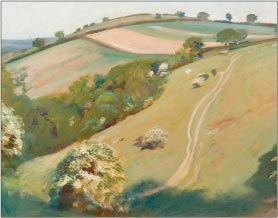
A view on Exmoor with bushes in blossom.
Landscape Paintings by Sir Alfred Munnings will be shown at Gainsborough’s House, Sudbury from 5 March to 4 June 2011.
Diane Perkins Director, Gainsborough’s House
Diane Perkins is the Curator of Gainsborough House and has previously contributed to our Magazine.
In the mid 1930s Lionel Edwards came to stay with my Grandfather, at Danbury, to paint The Essex Farmers Hunt. Whilst staying there he asked my Grandfather if he could meet Alfred Munnings, as he had never met him. My Grandfather knew Munnings and took Lionel Edwards to meet him at Dedham. A comment that was often quoted to me by my Father, who went along, was: Munnings to Edwards “Lionel, I wish I could paint your skies!” Lionel Edwards was a master at capturing skies, a skill where Munnings obviously felt he could do better.

Winter in our garden at Withypool, Exmoor.


